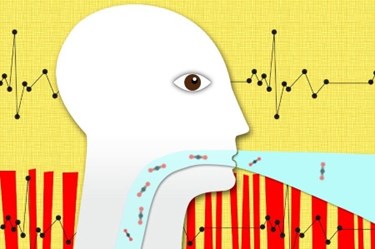MIT Researchers Teach An Old Medical Device New Tricks
By Chuck Seegert, Ph.D.

By repurposing a capnograph, a common medical device that measures carbon dioxide levels in a patient’s breath, a newly developed algorithm may help identify whether a patient with shortness of breath is suffering from emphysema or congestive heart failure. Once identified, proper treatment can be started, thus avoiding potentially deadly mistakes.
Shortness of breath, a condition known as dyspnea, is sometimes described as feeling a strong tightening of the chest accompanied by a sense of being suffocated, and it can be exhibited by a patient with congestive heart failure or by a patient with emphysema. A patient caught in the throes of dyspnea may not be able to speak or think clearly, which makes it difficult for first responders to identify the underlying cause. Diagnosis is critical, because getting it wrong may lead to an incorrect treatment path that could worsen the patient’s condition.
Measurable differences in capnograms exist between someone suffering from congestive heart failure (CHF) and another with chronic obstructive pulmonary disease (COPD, emphysema), according to a recent press release from the Massachusetts Institute of Technology (MIT). While tests currently exist, they require about an hour to run and must be performed in a lab, which isn’t helpful for a first responder.
“This machine is ubiquitous,” said George Verghese, the Henry Ellis Warren Professor of Electrical and Biomedical Engineering at MIT, in the press release. “It’s actually in every emergency department and operating room. But the use that they’ve typically made of it is much more limited than what we were attempting here.”
Graphing carbon dioxide levels and examining four physiologically based features of the capnogram with automated quantitative analysis led to interesting results, according to a study published by the team in IEEE Transactions on Biomedical Engineering. Patients with CHF had statistically different capnograph curves than patients with COPD. Moreover, from the shapes of the graph, the disease causing dyspnea could be determined with a high degree of accuracy. Importantly, this analysis could be run in real-time, eliminating the hour-long wait currently required for lab work.
A machine-learning algorithm was used to identify the critical capnograph features, according to the press release. Using sample datasets, the research team allowed a computer to find key variables in the curves that would distinguish between the disease types. Currently, the algorithm is undergoing a double-blind experiment in the field, and data is being collected alongside the standard treatment methods.
Shortness of breath can be a long-term condition that affects patients. Understanding its cause is the goal of other diagnostic approaches as well, according to a recent article on Med Device Online.
Image Credit: Christine Daniloff/MIT
